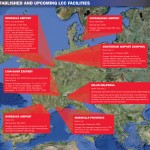Marseille-Provence airport is the gateway to the South of France and to Marseille, the country’s second largest city, which has a booming economy and dynamic tourism to Provence and the French Riviera. The airport will handle 7.35 million passengers this year – of which 1.65 million will be low-cost traffic handled through mp2. During the first six months of 2009, Marseille-Provence was among the Top 5 biggest increases in passenger traffic among Europe’s 100 busiest airports; it also exceeded the symbolic figure of 100 direct routes. While overall throughput is up by +4.3% so far this year, low-cost traffic is driving growth at a considerably higher rate at mp2. Travel to and from the French provinces is credited as being the biggest growth engine during the summer season, boosted by the launch of several new low-cost routes and reduced fares on existing routes. European routes have also grown strongly in recent years, with passenger numbers withstanding this year’s unfavourable economic context to record +0.8% growth.
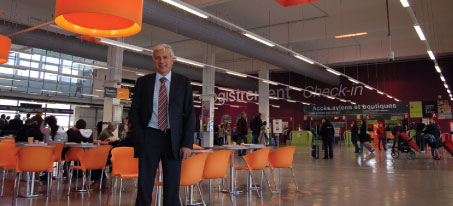
“We have achieved very good results from the commercial activities in mp2, such as travel value retail, F&B and car hire,” said Regis. Average per passenger spend at mp2 is €1 less than at mp1, which has a higher proportion of business travellers with more propensity to spend.
“mp2 has certainly helped us through the current economic crisis. Figures for the first nine months of 2009 show a +61.8% increase in passengers year-on-year at that terminal – that is significant and is the result of good acceptance of the low-cost model,” said Regis. “We expect 12% growth at mp2 to 1.8 million passengers in 2010 compared with 2% growth across the whole airport.”
He explained that the airport decided to build a dedicated low-cost facility in 2003, following a significant drop in traffic after 9/11 and the launch of high-speed rail services between Marseille and Paris, which together saw it lose 1.1 million passengers. “We had no option other than to develop our low-cost offer,” said Regis. “Our contact with low-cost airlines suggested they loved the airport and the area, but that it was too expensive and the facilities were not geared towards low-cost operations, so we adapted our premises to this type of operator.”
An old cargo terminal was converted and expanded from 4,500sqm to 9,000sqm into what is now mp2. It was a fast-track process; it took exactly three years from making the decision to develop a low-cost facility in September 2003 to receiving the first Ryanair aircraft in September 2006.
A Europe-wide tender was launched to find a carrier to occupy the new terminal, which three airlines answered – easyJet, Ryanair and Air France; easyJet and Ryanair then made solid offers and, as Regis put it, “Ryanair was more convinced of the market at Marseille-Provence”. Ryanair initially based two aircraft at mp2, subsequently adding a third in 2008 and a fourth in 2009. easyJet, Germanwings and Jet4you also operate from mp2, and a total of 31 destinations throughout Europe and Morocco are served from the facility.
Alfa-ACI
Alfa-ACI, the association of French-speaking airports associated with ACI, was created in 1991. It has 80 member airports on five continents, as well as 60 associate members. The main aims of the association are to study, share and propose joint positions on the management and promotion of French-speaking airports. The 20th Annual Alfa-ACI Conference & Exhibition will take place in Marrakech, Morocco, on 29 September to 1 October 2010. Alfa-ACI is also an active member of ACI EUROPE.
Reaching a new clientele
Regis attributes the strength of the mp2 product to the heavy segmentation of the offering at the airport. It was Europe’s first low-cost facility and the mp2 brand is now recognised as a benchmark. “Low-cost traffic now accounts for almost 23% of total traffic at Marseille-Provence. Traffic generated by low-cost operators in Marseille-Provence is additional traffic; existing traffic at the main terminal, mp1, used by legacy and charter airlines, has not been cannibalised,” said Regis, “In practice, even on routes already operated by legacy carriers, adding a low-cost option reaches a new clientele of passengers who did not travel by aircraft or who travelled less frequently.” The number of passengers on the Marseille-Lille route, for example, increased by +148% during the first half of 2009. This was due both to the introduction of low-cost services and a +7% increase in the full-service offering.
Level of charges
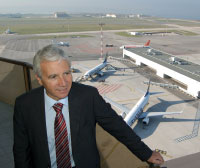
Regis: “Low-cost traffic now accounts for almost 23% of total traffic at Marseille. Traffic generated by low-cost operators in Marseille is additional traffic; existing traffic at the main terminal, mp1, used by legacy and charter airlines, has not been cannibalised.”
There is a strong differentiation between the level of charges applied at mp1 and mp2, with the passenger charge in the low-cost facility 70% lower; the landing and parking fees, meanwhile, are the same. Operational costs are lower at mp2, as it is a true low-cost offer, with no push back of the aircraft and no air bridges.
“For the French Civil Aviation Authority (DGAC), the low-cost terminal was a completely new project – they were surprised that we were offering a lower service with a lower rate,” said Regis. “The only airline that reacted was Air France, claiming that we were not applying the correct charge and that the full-service carriers were subsidising this. To solve that, the French DGAC had to spend three months at the airport from June 2008, during which time they checked our cost accounting and they testified that the way we were charging was correct. We have a very clear idea of what the correct cost is for each terminal.”
However, legal challenges are not over – Air France still has a pending claim that the airport received a subsidy from the City Council, as well as a claim that it has an illegal marketing contract with Ryanair. “The process is more time-consuming than anything,” said Regis, who is very confident about the outcome.
With the benefit of the experience acquired, would he change anything? “I would not change anything about the project – the terminal is perfect and Ryanair is very satisfied. We are very efficient and have a 25-minute turnaround.”
Route incentives
As part of its route development strategy, Marseille-Provence does incentivise airlines for the first three years of a new route. Landing fees are reduced by 60% in the first year, 40% in the second year and 20% in the third year. “As a result of the economic crisis, airlines are more demanding as far as costs are concerned. Even well-established airlines are still considering market results to see if the market is there. Airlines are very cautious about investment – airports have to incentivise,” said Regis.
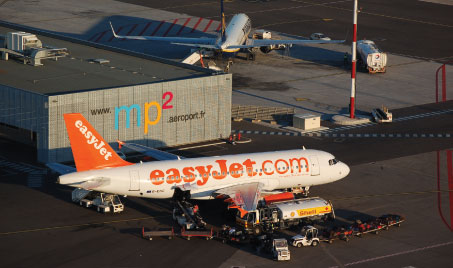
Marseille-Provence decided to build a dedicated low-cost facility in 2003, following a significant drop in traffic after 9/11 and the launch of high-speed rail services between Marseille and Paris, which together saw it lose 1.1 million passengers. The low-cost terminal, mp2, opened in September 2006.
Marseille-Provence’s good results this year are not exclusively due to traffic generated by the low-cost phenomenon and good levels maintained by the full-service carriers; the airport has for several years, successfully sought to open direct long-haul flights. “Launching direct long-haul flights fosters traffic growth, not least because most flights are into Paris, which is a substantial handicap for the French market,” said Regis.
There are currently seasonal long-haul routes from Marseille-Provence to destinations in Africa, The Indian Ocean and North America. There are also efforts to attract Asian carriers to Marseille. “Long haul from regional airports will be a niche market segment, but not high volume. Daily long haul services are not possible from regional airports,” said Regis. “Our seasonal routes serve particular types of market, such as cruise activity in Marseille – we are working on this type of route.” Rapid growth was registered on several international routes during the summer season, notably Algeria (+13.7%) and Morocco (+17.1%).
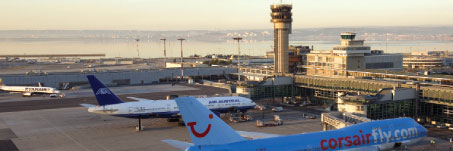
Marseille-Provence does incentivise airlines for the first three years of a new route. Landing fees are reduced by 60% in the first year, 40% in the second year and 20% in the third year.
The airport has also had strong development in the cargo segment. There was +8.5% growth in cargo traffic for the first nine months of 2009, with the airport expected to handle 45,000 tonnes of cargo this year – two thirds of that will be express freight.
Commercial revenues are also becoming increasingly important. “We have achieved very good results from the commercial activities in mp2, such as travel value retail, F&B and car hire,” said Regis. Average per passenger spend at mp2 is €1 less than at mp1, which has a higher proportion of business travellers with more propensity to spend.
Ahead of targets
Looking forward, there are plans to expand mp2 to double its current size, with 12 aircraft parking positions compared with the current six. At its current size, there is capacity to handle 3.7 million passengers. Growth is expected to come either from Ryanair or from new easyJet aircraft operating on routes not served by Ryanair. Currently, 90% of traffic is generated from aircraft based at Marseille-Provence and Regis sees potential to increase the number of services coming from aircraft based at other airports. In five years time it is expected that throughput will reach 8.5 million passengers with growth from low-cost operators.
“When I look back at where we were before the mp2 project and where we are today, I am very happy. We have adapted our product offer to what the market requires,” said Regis, “with strong benefits for our city and the entire region, in terms of economic development and tourism.” In 2009, the airport is a year ahead of its initial targets for mp2 – this is a result of the number of aircraft based at the terminal and the positive response of the French market.

